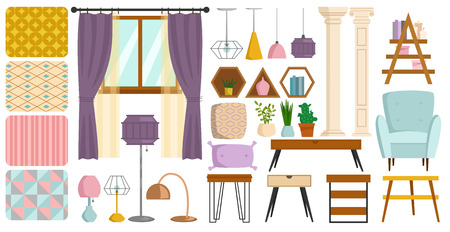Introduction to Pendant Lighting in British Period Homes
Pendant lighting has become an essential feature for those wishing to breathe new life into the timeless elegance of Georgian, Victorian, and Edwardian homes. These period properties, so abundant across Britain’s towns and villages, possess a unique architectural charm—soaring ceilings, ornate cornices, and grand sash windows set the stage for interiors that exude history and character. However, updating these spaces to suit modern living often raises questions about how to balance respect for heritage with the practicalities of contemporary daily life. Enter pendant fixtures: they offer not only a versatile source of illumination but also act as statement pieces that can harmonise old-world aesthetics with present-day functionality. From the dramatic sweep of a chandelier in a Georgian hallway to the subtle glow of a glass pendant over an Edwardian kitchen table, well-chosen lighting can highlight original features while making everyday routines more enjoyable. In this guide, we’ll explore room-by-room solutions for using pendant lights thoughtfully in British period interiors—ensuring each space remains true to its roots while feeling comfortably up-to-date.
Hallways and Entrances: Creating a Warm Welcome
When it comes to British period homes, first impressions truly count. Hallways and entrances are more than just transitional spaces—they set the tone for the entire household. These areas often feature high ceilings, intricate cornices, and narrow proportions typical of Georgian, Victorian, or Edwardian architecture. Choosing the right pendant lighting here can enhance original features while fostering an inviting atmosphere.
Pendant Lighting Suggestions for Period Hallways
| Feature | Recommendation | Why It Works |
|---|---|---|
| Classic Detailing | Opt for glass lantern pendants with brass or aged bronze finishes | Echoes traditional British craftsmanship and complements original mouldings |
| Proportion & Scale | Choose slim, elongated designs for narrow corridors; go bold with larger fixtures in grander vestibules | Prevents overcrowding while maximising ceiling height and sense of space |
| Warmth & Ambience | Select warm-toned bulbs (2200K–2700K) and frosted glass shades | Casts a welcoming, soft glow that gently highlights period details |
| Suspension Height | Hang pendants at least 2–2.4 metres above floor level | Avoids head bumps and allows architectural features to shine through |
| Heritage Touches | Consider fittings with subtle etched patterns or antique-style chains | Adds character while respecting the home’s history and aesthetic roots |
Clever Tips for British Hallways & Entrances
- Layer your lighting: Complement pendant lights with wall sconces or picture lights to reduce shadows in long corridors.
- Reflective accents: Position mirrors opposite pendants to bounce light around darker spaces and amplify natural daylight.
- Dimmable controls: Install dimmer switches to easily adjust the mood from bright and practical during busy mornings to soft and atmospheric for evening arrivals.
- Cohesive style: Choose pendant styles that echo other rooms’ fittings for a seamless flow throughout your period property.
Pendant lighting in hallways and entrances is about balancing function with heritage appeal. By selecting classic shapes, warm finishes, and appropriate scales, you create a heartening welcome every time you—or your guests—step through the door.

3. Living Rooms: Blending Style with Comfort
When it comes to British period homes, the living room is often the heart of the house, brimming with character and original features like ornate fireplaces, decorative cornices, and generous bay windows. Choosing the right pendant lighting here is all about enhancing these architectural gems while creating a space that feels both welcoming and refined. To achieve this, think in layers: start by pairing a statement pendant—perhaps a classic glass globe or an elegant metal lantern—with softer ambient lighting such as wall sconces or table lamps. This layered approach not only flatters period details but also allows you to adjust the mood from bright and lively for gatherings to softly lit and intimate for quiet evenings.
When selecting your pendant, consider how its design interacts with existing features. A pendant suspended above a coffee table or at the centre of a seating arrangement draws the eye without competing with a grand fireplace; opt for finishes that echo other elements in the room, like brass detailing to match door handles or antique bronze to tie in with picture frames. For rooms boasting beautiful cornices or high ceilings, ensure your pendant hangs low enough to create intimacy yet high enough to show off those stunning mouldings—generally about 75–90cm above surfaces works well. If you’re lucky enough to have a bay window, try positioning a smaller pendant within the alcove to highlight the architectural shape while providing a soft pool of light perfect for reading nooks.
Above all, aim for harmony between old and new: modern pendants can add a twist of contemporary style without overpowering period charm, especially when chosen in muted tones or classic materials. And don’t forget dimmer switches—they’re an easy way to tailor brightness throughout the day, ensuring your living room remains as cosy on a drizzly afternoon as it is elegant when entertaining guests after dark.
4. Kitchens: Marrying Functionality and Heritage
The British kitchen, especially in period homes, is often the heart of daily life—a place where tradition mingles with practicality. Choosing pendant lighting here is about more than just illumination; it’s about preserving character while enhancing usability. Vintage-inspired pendants with authentic finishes like aged brass or patinated copper can beautifully complement classic cabinetry and traditional tiled floors, nodding to the home’s heritage without feeling dated.
Tips for Pendant Lighting Over Kitchen Islands and Dining Nooks
- Proportion Matters: Choose pendants that are neither too large nor too small for your island or nook. For long islands, consider a row of smaller pendants; for compact spaces, a single statement piece works wonders.
- Height for Harmony: Hang lights around 75-90cm above the worktop. This ensures good visibility without blocking sightlines—ideal for sociable kitchens where everyone gathers round.
- Warmth in Finish: Opt for finishes that echo period details—think burnished metals, crackle glaze ceramics, or glass with subtle seeded textures. These materials settle naturally into a backdrop of painted shaker cupboards or encaustic tiles.
- Dimmable Options: Select fixtures compatible with dimmer switches. This allows you to switch from bright task lighting to softer ambient glows when supper lingers into evening chats.
Recommended Pendant Styles for Period Kitchens
| Pendant Style | Best Features | Suits These Details |
|---|---|---|
| Bowl-shaped Opal Glass | Diffuse glow, timeless silhouette | Butler sinks, tongue-and-groove panelling |
| Antique Brass Lanterns | Classic frame, warm patina | Painted cabinetry, quarry tiles |
| Ceramic Shades with Scalloped Edges | Cottage charm, soft reflectivity | Floral curtains, oak worktops |
| Caged Industrial Pendants | Nod to Victorian utility, robust look | Checkerboard floors, open shelving |
A Small Tip on Layering Light:
Pendant lighting works best when layered with under-cabinet LEDs or wall sconces. This keeps the room practical for chopping veg but atmospheric when it’s time to pour the tea. The right pendants not only highlight your kitchen’s features—they help you linger longer, bringing a sense of gentle rhythm to everyday routines.
5. Bedrooms: Soft Light for Restful Retreats
When it comes to bedrooms in British period homes, the goal is to create a restful haven that honours the original architecture while offering modern comfort. Pendant lighting can be the perfect finishing touch, especially if you’re working with high ceilings, decorative cornicing, or elegant alcoves commonly found in Victorian, Edwardian, or Georgian properties.
Choosing the Right Pendant Style
Opt for pendants with soft diffusers or frosted glass shades to ensure a gentle glow rather than harsh illumination. Classic shapes—think opal glass globes or vintage-inspired fabric shades—sit beautifully against ornate plasterwork and won’t compete with period details. If your ceiling is particularly lofty, consider a longer drop pendant that draws the eye upwards and accentuates the room’s proportions without overwhelming the space.
Working with Architectural Features
Original mouldings and ceiling roses are often focal points in British period bedrooms. Positioning your pendant centrally not only highlights these features but also creates balanced symmetry within the room. For alcoves, miniature pendants hung low on either side of the bed can replace traditional bedside lamps, freeing up surface space and adding a layered lighting effect that feels both cosy and uncluttered.
Creating a Clutter-Free Sanctuary
To foster a serene atmosphere, keep bedroom lighting schemes simple and cohesive. Limit yourself to one statement pendant as your main light source, supported by discreet wall lights or concealed LEDs for flexibility. Conceal cords where possible, and choose finishes—such as antique brass or matt black—that echo other hardware in the room for a streamlined look. The result is a calm retreat where every detail feels intentional, blending period charm with soothing modern minimalism.
6. Bathrooms: Elegance and Practicality
When it comes to bathrooms in British period homes, combining elegance with practicality is essential—especially if you’re lucky enough to have original features like a claw-foot tub or a vintage dressing table. Pendant lighting can add a subtle touch of glamour, but it’s important to select fixtures that are both moisture-safe and aesthetically sympathetic to the age of your property.
Choose Fixtures Designed for Damp Spaces
Start by prioritising pendants rated for bathroom use (look for IP44 or higher). This ensures safety without compromising on style. Glass shades with antique brass or matte black fittings evoke a timeless look while standing up to steamy conditions. Clear or frosted glass can diffuse light softly, perfect for a relaxing soak or morning routine.
Highlight Character Features
If your bathroom boasts heritage details, position a pendant directly above a freestanding bath or beside a classic vanity. This draws attention to period features while creating practical task lighting for grooming. Opt for single pendants with decorative chains or fluted glass to echo Edwardian or Victorian influences without overpowering the space.
Keep It Balanced and Functional
In smaller bathrooms, avoid oversized fittings—choose compact pendants that offer sufficient illumination without overwhelming the proportions. For larger rooms, consider pairing two matching pendants over double sinks or along either side of a window to maintain symmetry and period charm. Always ensure fittings are installed at a safe height from water sources and consult a qualified electrician familiar with UK bathroom regulations.
With thoughtful choices, pendant lighting brings both sophistication and everyday utility to your period bathroom—creating an inviting retreat that honours your home’s unique character.
7. Tips on Sourcing and Installing Pendant Lighting for Period Properties
When it comes to choosing pendant lighting that complements your British period home, authenticity and sensitivity to original features are key. The UK is blessed with a wealth of resources for sourcing both genuine vintage fittings and faithful reproductions.
Where to Find Authentic or Reproduction Pendant Lights
Specialist Antique Dealers
Seek out reputable antique lighting dealers across Britain—particularly in areas known for antiques like the Cotswolds, Bath, and London’s Lillie Road. Here you’ll find everything from Edwardian opaline glass pendants to ornate Victorian lanterns. Always check provenance and condition, and don’t hesitate to ask about rewiring and certification.
Reproduction Lighting Suppliers
If you prefer the reliability of modern electrics with period charm, look to specialist suppliers such as Jim Lawrence, Fritz Fryer, or Holloways of Ludlow. They offer designs inspired by different eras—Georgian, Regency, Arts & Crafts—with options for custom finishes and fittings.
Salvage Yards and Architectural Reclamation Centres
Places like Lassco or Retrouvius can be treasure troves for those patient enough to hunt. Salvaged pendants often come with stories of their own—just remember that professional rewiring is essential before installation.
Considerations for Safe and Sympathetic Installation
Respecting Original Features
Avoid damaging original plasterwork, cornicing, or ceiling roses. Where possible, reuse existing holes or fixings. If in doubt, consult a conservation specialist or heritage electrician who understands the nuances of listed buildings.
Cable Management and Positioning
Use fabric-braided flexes and discreet ceiling roses in traditional finishes (antique brass, bronze) to blend seamlessly with period detailing. Consider using hooks or offset pulleys when centring a pendant isn’t possible due to old joist positions—these small touches can add character while solving practical problems.
Complying With UK Electrical Standards
Always use a qualified NICEIC-registered electrician experienced in period properties. They’ll ensure compliance with current Part P regulations without compromising decorative features—and will also advise on appropriate bulb wattages to avoid overheating fragile shades or fixtures.
Final Thought
The right pendant light is more than just illumination—it’s an opportunity to enhance your home’s historic character while meeting the needs of modern living. With careful sourcing and considerate installation, your chosen fittings will feel as though they’ve always belonged.


